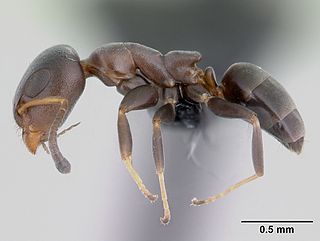
Dolichoderinae is a subfamily of ants, which includes species such as the Argentine ant, the erratic ant, the odorous house ant, and the cone ant. The subfamily presents a great diversity of species throughout the world, distributed in different biogeographic realms, from the Palearctic, Nearctic, Afrotropical region and Malaysia, to the Middle East, Australian, and Neotropical regions.

Turneria is a genus of ants that belongs to the subfamily Dolichoderinae. Known from Australia, they form small colonies of fewer than 500 workers, and nest in trees and twigs.

The flame-colored tanager, formerly known as the stripe-backed tanager, is a medium-sized American songbird in the family Cardinalidae, the cardinals or cardinal grosbeaks. It is found from Mexico throughout Central America to northern Panama and occasionally in the United States; four subspecies are recognized. The flame-colored tanager is 18 to 19 cm long, the male having predominantly red-orange while the female is more yellowish orange.

Monomorium bidentatum is a species of ant in the subfamily Myrmicinae. It is endemic to two South American countries, Chile and Argentina.

Clausilia bidentata, the two-toothed door snail, is a species of door snails, terrestrial pulmonate gastropod mollusks in the genus Clausilia belonging to the family Clausiliidae, all of which have a clausilium.
Nurteria is a genus of flies in the family Dolichopodidae, found in the Afrotropical realm. Three species are currently known in the genus, but there are also numerous undescribed species of the genus from southern Africa. It was originally described in the subfamily Diaphorinae, though it possesses some features of the Sympycninae.
Tanaocheles is a genus of crabs, the only genus in the family Tanaocheleidae. It contains two species, T. bidentata and T. stenochilus. The two species were formerly placed in different families, and they were only shown to be related, and placed in a new subfamily, in 2000.

Platythyrea is a genus of predaceous ants in the subfamily Ponerinae and the sole member of the tribe Platythyreini.
A. bidentata may refer to:
T. bidentata may refer to:

Haidomyrmecinae, occasionally called hell ants, are an extinct subfamily of ants (Formicidae) known from Cretaceous fossils found in ambers of North America, Europe, and Asia, spanning the late Albian to Campanian, around 100 to 79 million years ago. The subfamily was first proposed in 2003, but had been subsequently treated as the tribe Haidomyrmecini and placed in the extinct ant subfamily Sphecomyrminae. Reevaluation of the Haidomyrmecini in 2020 lead to the elevation of the group back to subfamily. The family contains the nine genera and 13 species.

Leptomyrmecini is a tribe of Dolichoderinae ants with 16 genera and two extinct genera.
Turneria collina is a species of ant in the genus Turneria. Described by Shattuck in 1990, the species is endemic to Papua New Guinea.
Turneriapostomma is a species of ant in the genus Turneria. Described by Shattuck in 1990, the species is endemic to Papua New Guinea.
Turneria dahlii is a species of ant in the genus Turneria. Described by Forel in 1901, the species is endemic to New Guinea, the Solomon Islands and Vanuatu.
Turneria frenchi is a species of ant in the genus Turneria. Described by Auguste-Henri Forel in 1911, it is endemic to Australia, but original specimens of the ant have been lost, and its placement in a genus has been in question. The ant has been transferred various times, notably being transferred to Stigmacros in 1990 but then put back into Turneria in 1992.
Turneria rosschinga is a species of ant in the genus Turneria. Described by Shattuck in 2011, the species is endemic to Australia.
Idiocnemis is a genus of damselflies in the family Platycnemididae. They are distributed on New Guinea and the surrounding islands. There are 20 species.
Nupserha bidentata is a species of beetle in the family Cerambycidae. It was described by Johan Christian Fabricius in 1792, originally under the genus Saperda.

Ovatella is a genus of gastropods belonging to the family Ellobiidae.









